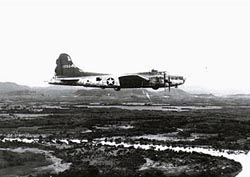
B-17G Flying Fortress No. 44-83690 in Peru, Indiana, is a rare intact example of the important World War II heavy bombers manufactured by the Douglas Aircraft Company in Long Beach, California. Douglas was one of two companies other than Boeing designated to manufacture B-17s during World War II. General features on the B-17 include its mid-wing monoplane design, aluminum-clad exterior, four radial engines, massive wing structure and heavy armament. Although many U.S. airmen and craft contributed to the Allied victory in World War II, the B-17 has become especially symbolic of the self-reliance, daring and sacrifice of American airmen during the war. American confidence in the B-17 became the cornerstone for the Air Corps doctrine of strategic "daylight" bombing in German-occupied Europe.

While the B-17s were used in the Pacific, by 1944 the B-29 had replaced the B-17 for use in the Pacific Theater. B-17s were initially intended as a fast, land-based bomber, which could patrol at sea and intercept naval vessels. B-17Cs were the first of the series to see action. Twenty were flight delivered to the Royal Air Force on the Lend-Lease agreement in 1940. The British pressed them into bombing well-protected sites, but the B-17Cs proved to be undergunned and performed poorly in this task, so Boeing engineers redesigned the tail assembly and improved firepower. The improved version was the B-17E. The E model was the most advanced type of B-17 when the U.S. entered World War II. They were the first American-manned B-17s to see action in the European Theater. B-17Fs had increased armament including guns that fired through the nose window or nose check area, and a single gun that could be fired upward from a dorsal window aft of the top turret. The final improvement on the B-17 was the G series, introduced in July 1943. Firepower was boosted, with a twin-gunned, power operated chin turret added to counter head-on attacks by the German Luftwaffe. Angled cheek gun ports on the nose area also introduced increased firepower. Waist gunner windows were staggered to allow greater freedom of movement for the gunners. The tail turret was now power operated.

The G series could hold a crew of 10, including pilot, co-pilot, bombardier, radio operator, navigator, dorsal turret gunner, two waist gunners, ball turret gunner and tail gunner. Typical for B-17Gs are the four 1,380-horsepower Wright GR1820-97 Cyclone air-cooled, nine-cylinder radial engines equipped with exhaust driven turbochargers. The radial engines of 44-83690 are still intact, but would likely require a complete overhaul to be functional. The wingspan is 103 feet, 9 inches--longer than the typical B-17Gs span of 74 feet, 4 inches in length. General features include the raised cockpit section and Plexiglas nose cone. Characteristic of all B-17s, starting with the E series, is the massive dorsal fin, which gracefully sweeps to merge with the fuselage. All B-17s have retractable tail-wheel landing gear. The empty weight of the airplane is 32,720 pounds. Fully armed and loaded, B-17s weigh 65,600 pounds. Payloads of 4,000-5,000 pounds were typical but up to 17,6000 pounds could be carried for less than maximum range. The maximum speed was 300 miles per hour at 30,000 feet.
No.44-83690 is a representative G-series B-17. It was delivered for use on May 9, 1945 and assigned to Patterson Air Force Base in Ohio, 4100 Base Unit, where it was put into storage. On November 14, 1945, it was assigned to 4168 Base Unit (Air Material Command), South Plains Field, Texas. In June of 1947, it was transferred to 4141 Base Unit, Air Material Command, Pyote Field, Texas. This B-17G is also an example of an experimental aircraft that participated in nuclear and radio-guided unmanned aircraft testing shortly after World War II. In February 1951, it flew to Kwajalein (Marshall Islands) in the South Pacific to participate in Operation Greenhouse. From 1956 until 1959 it was assigned to the 3235th Drone Squadron, Missile Test Center, Patrick Air Force Base in Florida. The test center evaluated Nike, Talos, Genie, Bomarc and Sidewinder missiles by destroying B-17s. In some cases, intentional partial hits were used to evaluate results. One of the last active military B-17s, 44-83690 was removed from the official Air Force inventory in August 1960. Its last flight was to Grissom Air Force Base (then known as Bunker Hill) for permanent display in 1961. The Heritage Museum Foundation, now the Grissom Air Museum, was established in 1981 as part of the Air Force Museum Program and maintains the airplane. The museum, which is open to the public without having to enter the base itself, displays aircraft which have been used by the 305th Group throughout its history.
Visit the National Park Service Travel American Aviation to learn more about Aviation related Historic Sites.
Last updated: August 22, 2017
